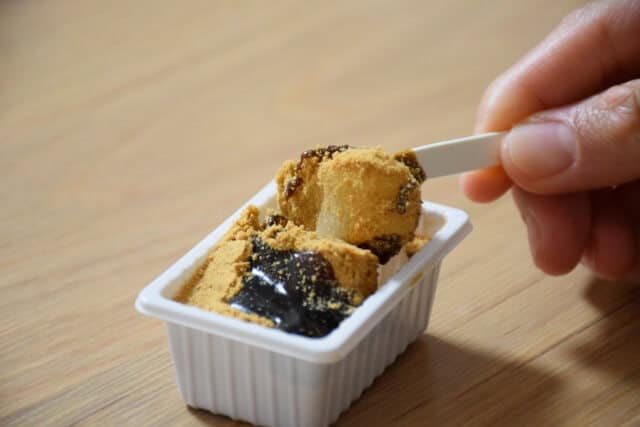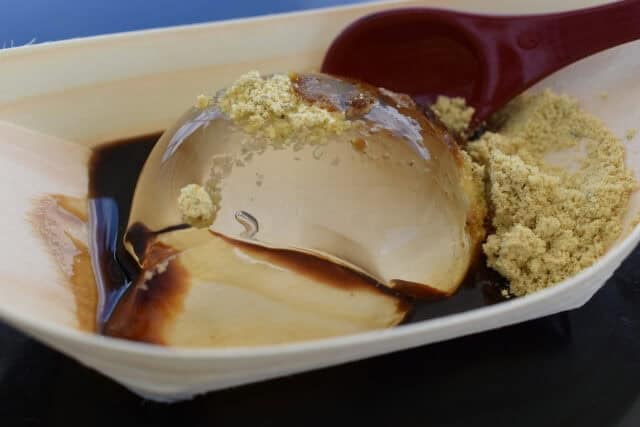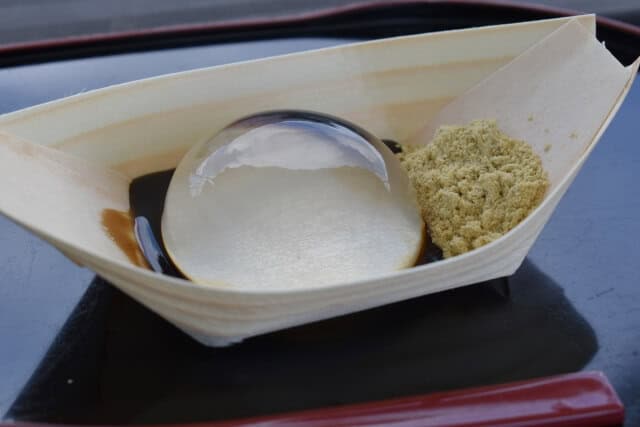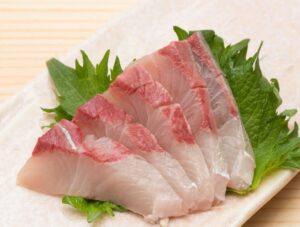If you adore learning about various cultures and experiencing new foods, Shingen mochi is a traditional Japanese sweet that you should absolutely try. Shingen mochi has a soft, chewy texture and a sweet, nutty flavor that is unlike anything else. Made from glutinous rice, kinako (roasted soybean flour), and brown sugar syrup. Shingen-mochi is a must-try that will satisfy your taste buds and give you a deeper respect for Japanese culture. Therefore, join us on this adventure to uncover the delights of Shingen mochi!
What is Shingen mochi?

Shingen mochi is a souvenir confectionery and Japanese confectionery in Yamanashi prefecture. It is a kind of mochi made by kneading water and sugar into the powdered glutinous rice. Then, sprinkled with kinako (roasted soybean flour), topped with brown sugar syrup, and eaten with the attached toothpick. It is a standard souvenir from Yamanashi, and many people eat it. When you put it in your mouth, it melts away, and the sweetness spreads slightly through the mixture of soybean flour and brown sugar syrup.
Shingen mochi History

Kikyo Shingen Mochi
About 1960, when a Western confectionery boom spread through Japan, specialized retailers from outside Yamanashi Prefecture entered the market. To match the tastes of the Japanese people, the creation of a new sweet began. Therefore, Kikyo Shingen Mochi was born. The evolution of Abekawa Mochi served as one of the inspirations for Kikyo Shingenmochi. Abekawa-mochi, a rice cake coated with kinako and brown sugar syrup, has been a traditional Obon season treat in Yamanashi Prefecture for decades. Kikyo Shingenmochi was invented as a modern-style confection that everyone can eat all year round, not only around Obon. As a result, Yamanashi Prefecture has become a popular tourist destination, and Kikyo Shingenmochi gained widespread recognition as a Yamanashi specialty, thanks to the power of the mass media.
Mizushingen Mochi
Locals in Hokuto-cho began mixing fresh mineral water into the dessert in modern Japan. The Kinseiken Seika Company in Yamanashi Prefecture was among the first to offer it on weekends. The creator planned to experiment with generating edible water the year before, in 2013. The dessert became a viral hit, and people traveled long distances to try it. Darren Wong debuted the dish to the United States at the Smorgasburg food event in New York City in April 2016. Soon after, the London restaurant Yamagoya worked for four months to create a new version.
About its Name

The samurai warlord Takeda Shingen, who was a well-known warrior in Japan during the Sengoku period, is the inspiration for the name of the Shingen mochi. The Japanese rice cake known as mochi, fashioned from glutinous rice, was a favorite of Takeda Shingen’s. It is unclear exactly how this specific variety of mochi came to be connected with Takeda Shingen, but one widely accepted theory is that his wife invented it so that her husband would have a portable and nourishing snack to take with him on his military excursions. According to a different story, the confection was given the name “Shingen mochi” in memory of the samurai commander after his passing.
Inside Kikyo Shingenmochi

Kikyo Shingenmochi is a combination of soybean flour, rice cake, and thick brown sugar syrup. If you compare it with other similar products or black sugar syrup sold at supermarkets, you can see its unique richness. Talebin with brown sugar syrup is now fully automated (of course, Kikyoya’s custom honey-filling machine), but in the past, each bottle was filled manually with a dropper and the lid was closed.
Inside Mizushingen Mochi

Mizushingen mochi consists of only a small amount of agar, adding it to the underground water of Mt.Kaikomagatake. Therefore, this water sweet is almost water that keeps a state as close to the water as possible. In addition, the soybean flour and black syrup on the water Shingenmochi are both specially made by Kinseiken.
Nutritional content

Kikyo Shingen mochi
The main nutritional component of Shingen mochi is sugar. Carbohydrates are one of the three major nutrients along with lipids and proteins that it contains. Therefore, a lack of it can lead to hypoglycemia and to physical problems such as headaches, lightheadedness, chronic fatigue, and decreased ability to think. Additionally, it contains high-quality protein.
Mizu Shingen Mochi
Since its agar is from seaweed, one of the nice points is that it is low in calories. By adding kinako (roasted soybean flour) and brown sugar syrup to the toppings, you can expect to replenish the protein that builds muscles, as well as the vitamins and minerals that help you metabolize energy efficiently.
Shingen mochi FAQ
- What are some festivals and events in Japan where they serve Shingen mochi?
-
Shingen mochi, connected to the historical warlord Takeda Shingen and is associated with the Shingen-ko Festival in Kofu. Locals sell this by several vendors. Abekawa mochi, a traditional dessert that respects ancestors, is traditionally consumed during the Obon festival in Yamanashi Prefecture. Shingenmochi, a much more modern take on this dessert, is occasionally offered.
- What are some other types of wagashi that are similar to Shingen mochi?
-
Other types of wagashi with similar texture and ingredients to Shingenmochi include Warabi mochi made from bracken starch, Mizu yokan which is a jelly made from red bean paste, sugar, and agar with a soft texture, and Kuzumochi made from kudzu starch which has a jelly-like texture and a translucent appearance.
Shingen mochi Recipe

Shingen mochi Ingredients
| Ingredients of Shingen mochi for 2 persons | Measurements |
|---|---|
| Shiratamako | 100g |
| Water | 195g |
| Sugar | 80g |
| Soybean flour | 20g |
| Brown sugar | 80g |
How to make Shingen mochi
Put Shiratamako and water in a bowl and mix to dissolve the shirataki. Then, add sugar and mix.
Heat in the microwave at 500W for 1 minute and 30 seconds and mix. Repeat the same process a total of 3 times.
Put soybean flour in a bowl, put 2 on top, and sprinkle with soybean flour. You should push and stretch it by hand. Sprinkle more flour and transfer it to the refrigerator to cool and harden.
Put brown sugar and water in a bowl and mix until the brown sugar dissolves. Cover with plastic wrap and heat in the microwave for 2 minutes at 500W.
Transfer to a cutting board and cut to the desired size. Serve on a plate and sprinkle the remaining soybean flour.
Where to buy Shingen mochi?
Kinseiken Daigahara Main Store (金精軒 台ヶ原本店)

Kinseiken, which manufactures and sells this Shingen mochi, gained popularity for a long time since it started selling in 2013, “Mizushingen mochi”. Unlike Shingen mochi, Mizushingen mochi is not popular as a souvenir all over the country, so the only way to eat it is to actually visit Kinseiken in Yamanashi prefecture.
Final Thoughts

Shingen mochi is a unique and delectable Japanese sweet with a lengthy history and significant cultural importance. Hopefully, this article has given you insightful knowledge on the dish’s history, ingredients, and origins in Japan. Include Shingen mochi on your list of delicacies to taste if you’re planning a trip to Japan.
Many souvenir shops and department stores also carry it, and some even offer nationwide delivery. Keep in mind that due to its delicate nature, Shingenmochi has a short shelf life and should be consumed within a few days of purchase. So, if you have the chance, be sure to grab a box and enjoy the unique texture and subtle sweetness of this traditional Japanese sweet.
You can check some Japanese mochi dishes that we know you would like to try too.
















Comments